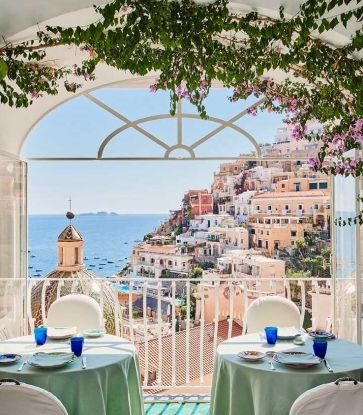Working silently, Carlos Sánchez wields a long, thin cuchillo jamonero (ham knife) possessing the springy flexibility of a fencing sword. With a graceful motion, he sweeps the slender blade forward along la maza (the thick rump) of a jamón Ibérico (Iberian ham), expertly slicing a 1-millimeter-thin loncha (slice) off. The small rectangle is a contrast between ruby red meat and bright white fat, which ribbons through it or runs along its edges. Once a piece is cut, Sànchez carefully lays it down on a platter, slightly overlapping it with its neighbor.
Each ham yields approximately 2,600 lonchas. Every slice will taste slightly different, depending on the percentage of meat and fat contained within it. To hone in on those subtle variations, Sànchez recommends pressing a loncha to the roof of your mouth with your tongue. Hold it there for a few seconds to savor the flavor while the fat melts, and then chew the remaining meat.

Stationed in an upstairs dining room at Fabio Trabocchi's svelte Spanish seafood restaurant, Del Mar, located at the heart of Washington, D.C.'s ritzy new Wharf development, Sànchez is cutting the lonchas from a sizeable ham that wouldn't look out of place in Fred Flinstone's hand. It's cradled in an artfully designed, curved metallic stand known as a jamonera, which allows the carver to swivel the meat every which way to get the best access for cutting.
The fatty exterior of the bone-in, hoof-on ham is aged yellow and mottled, but Sànchez has already cut some of it away to reveal the meaty core. Only after this outside fat has been trimmed can he truly determine the quality of the ham. If it appears it hasn't been aged enough—an extreme rarity—the ham must be discarded, because it is impossible to restart the curing process.
Carving Ibérico ham has been Sánchez's work for more than a decade. Completely self-taught, it took him a year just to get the lonchas the right size and thickness.
Now he does it with a practiced ease that belies the intense difficulty of consistently producing such uniform slices. During his career, he has carved at Michelin-starred restaurants across Spain and for numerous high-profile guests—including members of the Spanish royal family and Real Madrid soccer players—transforming tens of thousands of hams into millions of lonchas.
This painstaking work has helped him earn the unofficial title of "Master Jamón Carver." The self-taught maestro takes a Zen-like approach to his art. "It's about creating harmony in every slice and every plate," says the native Spaniard, speaking through an interpreter. "Whenever I get comfortable, I try to modify what I'm doing and do something new. I feel like I'm learning all the time."

He currently works for Cinco Jotas, which has been producing Ibérico hams since 1879. The company's hams come from black-skinned Iberian pigs, which have a conical snout and ears that flop forwards above their eyes. In order to be certified jamón Ibérico, the pig must be 100 percent pure Iberian. There can be no crossbreeding in the animal's history, whose genealogy is carefully documented by the Spanish Association of Iberian Pig Breeders (Aeceriber).
The pigs are raised free-range on oak covered pastures, known as dehesas, in the mountainous region of Spain's southwestern Iberian Peninsula. They travel nearly nine miles a day foraging for food, including acorns, grass, roots and herbs. Most abundant between October and March (a time called the Montanera), the nuts are what help the pig develop fat and flavor. The animal's genealogical purity and its acorn diet are the key elements for a jamón Ibérico to earn the highest rating: the black label, otherwise known as the pata negra (black hoof).
Each hog yields two jamones (hind leg cuts), each weighing roughly 17 pounds, and two paletas (shoulder cuts), which each clock in at approximately 11 pounds. They can spend up to five years in Cinco Jotas's bodegas (curing cellars) before being released for sale. However, it can take just a couple hours for Sànchez to reduce one to ribbons.
To see the master carver in action, visit Fabio Trabocchi's restaurants until the end of the year. Sànchez will be doing presentations for diners, while training members of the staff, who might one day become master jamón carvers themselves.
Photos courtesy of Cinco Jotas.











